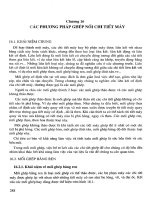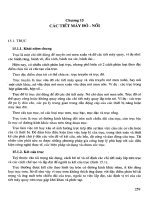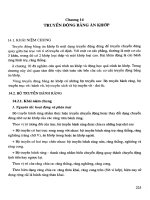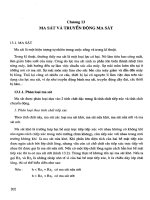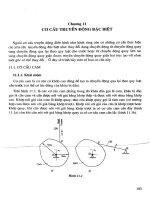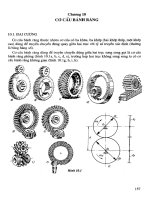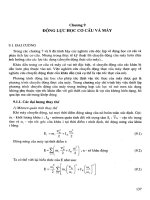Petroleum geoscience (cơ sở kỹ THUẬT dầu KHÍ SLIDE TIẾNG ANH)
Bạn đang xem bản rút gọn của tài liệu. Xem và tải ngay bản đầy đủ của tài liệu tại đây (4.64 MB, 129 trang )
Vietnam National University - Ho Chi Minh City
University of Technology
Course
Introduction to
Petroleum Engineering
Presenter: Trần Nguyễn Thiện Tâm
Falcuty: Geology & Petroleum Engineering
Department: Drilling - Production
Email:
3/29/21
Introduction to Petroleum Engineering
1
Chapter 2
Petroleum
Geoscience
3/29/21
Introduction to Petroleum Engineering
2
Contents
Generation of hydrocarbon
Petroleum system
Requirements for petroleum accumulation
3/29/21
Introduction to Petroleum Engineering
3
Learning outcomes
Explain the generation of hydrocarbon.
List the kerogen components.
Differentiate the kerogen types and related hydrocarbon.
Apply the Van Krevelen diagram to define the kerogen types.
Define the characteristic parameter of oil window.
Analyse the role of components and processes of petroleum
system.
Summarise the requirements for petroleum accumulation.
3/29/21
Introduction to Petroleum Engineering
4
Generation of hydrocarbon
3/29/21
Introduction to Petroleum Engineering
5
Diagenesis of Organic Matter
There are three important stages in the burial and evolution of
organic matter into hydrocarbons:
Diagenesis;
Catagenesis;
Metagenesis.
3/29/21
Introduction to Petroleum Engineering
6
Diagenesis
Diagenesis of organic matter begins as soon as sediment is
buried. However, the point at which diagenesis ends is subject to
how the term is used. Some geologists use the term in a
restricted sense to include only processes that occur as
sediment consolidates into sedimentary rock.
3/29/21
Introduction to Petroleum Engineering
7
Diagenesis
Freshly deposited muds are
unconsolidated
and
may
contain more than 80% water
in their pores. These muds
compact very quickly. Most of
the porosity is lost in the first
500 meters of burial. After that,
compaction to form mudstones
or shales continues much more
slowly.
3/29/21
Introduction to Petroleum Engineering
8
Kerogen Components
Under the microscope, kerogen appears as disseminated organic
fragments. Some of this material is structured. It is recognizable
as plant tissue fragments, spores, algae, and other pieces with a
definite biological organization. These plant-derived structured
fragments can be grouped into distinct biological units called
macerals. Macerals in kerogen are equivalent to minerals in
rocks.
Three major maceral groups are important: vitrinite, exinite and
inertinite.
3/29/21
Introduction to Petroleum Engineering
9
Kerogen Components
Vitrinite is the dominant maceral type in many kerogens and is
the major component of coal. It is derived almost entirely from
woody tissue of the higher land plants. Because it is derived from
lignin and is difficult to break down, vitrinite can appear in
almost any depositional environment, marine or nonmarine,
and is generally the most abundant type of structured particle.
3/29/21
Introduction to Petroleum Engineering
10
Kerogen Components
Exinite macerals are mainly derived from algae, spores, pollen,
and leaf-cuticle waxes. High percentages of exinite are not
common, but if present, they usually imply lacustrine or
shallow marine environments.
3/29/21
Introduction to Petroleum Engineering
11
Kerogen Components
Inertinite macerals come from various sources that have been
extensively oxidized before deposition. Charcoal, derived from
woody plants, is the major recognizable type. Inertinite is usually
a minor component of kerogen, and is abundant only where
much of the organic matter has been recycled.
3/29/21
Introduction to Petroleum Engineering
12
Kerogen Components
In addition to the structured macerals, some of the components
of kerogen are amorphous. Amorphous particles have been so
mechanically broken up and/or chemically altered by bacteria
and fungi that their original maceral types and cell structures
have been obliterated. Amorphous particles are not true
macerals but alteration products, although the maceral term
"amorphinite" has sometimes been applied to these materials.
3/29/21
Introduction to Petroleum Engineering
13
Hydrocarbons and Kerogen Type
The
macerals
and
amorphous particles in
kerogen
affect
its
ability to generate
hydrocarbons.
Oilprone
kerogens
generally are made of
more than 65% exinite
and
amorphous
particles.
3/29/21
Introduction to Petroleum Engineering
14
Hydrocarbons and Kerogen Type
Kerogens with 65% to
35%
of
oil-prone
components will expel
mostly
condensate
and wet gas. With less
than 35% oil-prone
constituents,
the
kerogen will yield dry
gas if dominated by
vitrinite and will be
non-reactive
and
barren if dominated by
inertinite.
3/29/21
Introduction to Petroleum Engineering
15
Kerogen Type
Kerogen Type
Origin
Organic Constituents
I Algal
Algae
of
marine, Mostly algal components: of
lacustrine,boghead coal exinite
(alginite);
some
environments
amorphous material derived from
algae
II Mixed Marine
Decomposition
in Amorphous particles derived
reducing environments, mostly
from
phytoplankton,
mostly marine
zooplankton,
and
higher
organisms; also some macerals
from these groups
III Coaly
Debris of continental Mostly vitrinite;some exinite (not
vegetation (wood, spores, algal)
and
amorphous
leaf cuticle wax, resin, decomposition products
plant tissue )
IV Inert
Fossil charcoal and other Mostly
inertinite;
some
oxidized
material
of amorphous
decomposition
continental vegetation
products
3/29/21
Introduction to Petroleum Engineering
16
Kerogen Type
Type I, or algal kerogen, is rich in the algal components of
exinite, and is formed in either lacustrine or marine
environments. Type I kerogen is derived mainly from lipids and
tends to produce crudes that are rich in saturated
hydrocarbons.
3/29/21
Introduction to Petroleum Engineering
17
Kerogen Type
Algae
3/29/21
Introduction to Petroleum Engineering
18
Kerogen Type
Type II is a kerogen derived from mixed marine sources. Its
particles are mostly amorphous and result from the
decomposition of phytoplankton, zooplankton, and some higher
animals. Its chemical nature is intermediate between Types I and
III. Type II kerogens tend to produce naphthenic and aromaticrich oils, and they yield more gas than Type I.
3/29/21
Introduction to Petroleum Engineering
19
Kerogen Type
Phytoplankton
3/29/21
Introduction to Petroleum Engineering
20
Kerogen Type
Zooplankton
3/29/21
Introduction to Petroleum Engineering
21
Kerogen Type
Zooplankton
3/29/21
Introduction to Petroleum Engineering
22
Kerogen Type
Type III or coaly kerogen, is rich in vitrinite macerals, and
therefore has a very low capacity to form oil. It mainly generates
dry gas. Any oils generated from Type III kerogens are mostly
paraffinic waxy crudes derived from its exinite and amorphous
constituents.
3/29/21
Introduction to Petroleum Engineering
23
Kerogen Type
Neuropteris flexuosa fossil plant
3/29/21
Introduction to Petroleum Engineering
24
Kerogen Type
Type IV is rich in inertinite macerals and produces very low
hydrocarbon yields. Inertinite is, as its name implies, inert and
has practically no ability to generate either oil or gas.
3/29/21
Introduction to Petroleum Engineering
25


